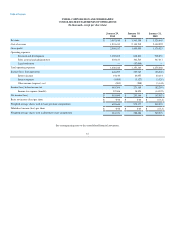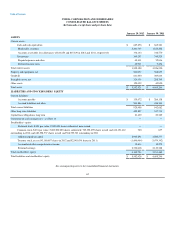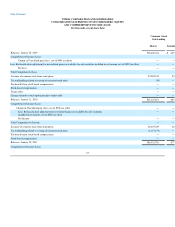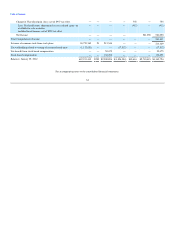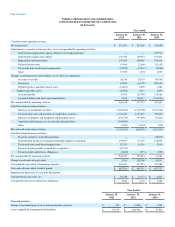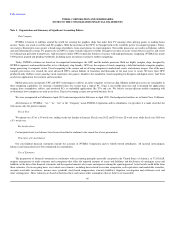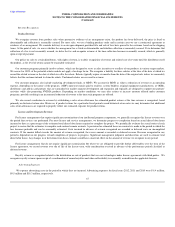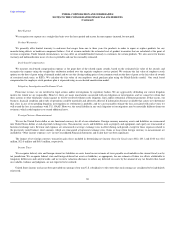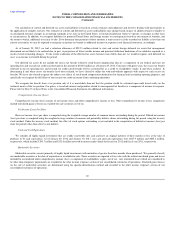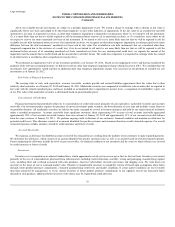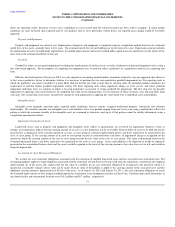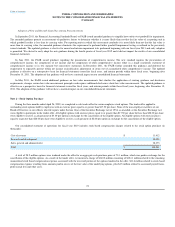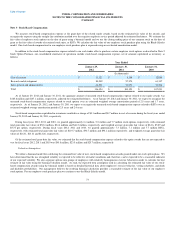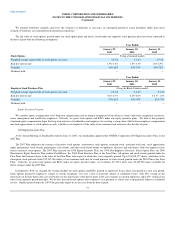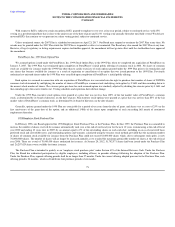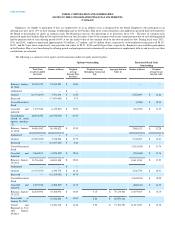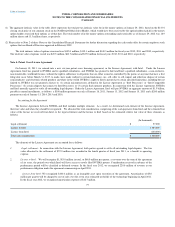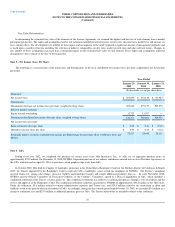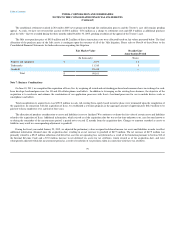NVIDIA 2012 Annual Report Download - page 72
Download and view the complete annual report
Please find page 72 of the 2012 NVIDIA annual report below. You can navigate through the pages in the report by either clicking on the pages listed below, or by using the keyword search tool below to find specific information within the annual report.
Table of Contents NVIDIA CORPORATION AND SUBSIDIARIES
NOTES TO THE CONSOLIDATED FINANCIAL STATEMENTS
(Continued)
All of our available-for-sale investments are subject to a periodic impairment review. We record a charge to earnings when a decline in fair value is
significantly below cost basis and judged to be other-than-temporary, or have other indicators of impairments. If the fair value of an available-for-sale debt
instrument is less than its amortized cost basis, an other-than-temporary impairment is triggered in circumstances where (1) we intend to sell the instrument,
(2) it is more likely than not that we will be required to sell the instrument before recovery of its amortized cost basis, or (3) a credit loss exists where we do
not expect to recover the entire amortized cost basis of the instrument. If we intend to sell or it is more likely than not that we will be required to sell the
available-for-sale debt instrument before recovery of its amortized cost basis, we recognize an other-than-temporary impairment in earnings equal to the entire
difference between the debt instruments’ amortized cost basis and its fair value. For available-for-sale debt instruments that are considered other-than-
temporarily impaired due to the existence of a credit loss, if we do not intend to sell and it is not more likely than not that we will be required to sell the
instrument before recovery of its remaining amortized cost basis (amortized cost basis less any current-period credit loss), we separate the amount of the
impairment into the amount that is credit related and the amount due to all other factors. The credit loss component is recognized in earnings while loss related
to all other factors is recorded as other comprehensive income (loss).
We performed an impairment review of our investment portfolio as of January 29, 2012. Based on our impairment review and having considered the
guidance of the relevant accounting literature, we did not record any other than temporary impairment charges during fiscal year 2012. We concluded that our
investments were appropriately valued and that no additional other than temporary impairment charges were necessary on our portfolio of available for sale
investments as of January 29, 2012.
Fair Value of Financial Instruments
The carrying value of cash, cash equivalents, accounts receivable, accounts payable and accrued liabilities approximate their fair values due to their
relatively short maturities as of January 29, 2012 and January 30, 2011. Marketable securities are comprised of available-for-sale securities that are reported at
fair value with the related unrealized gains and losses included in accumulated other comprehensive income (loss), a component of stockholders’ equity, net
of tax. Fair value of the marketable securities is determined based on quoted market prices.
Concentration of Credit Risk
Financial instruments that potentially subject us to concentrations of credit risk consist primarily of cash equivalents, marketable securities and accounts
receivable. Our investment policy requires the purchase of top-tier investment grade securities, the diversification of asset type and includes certain limits on
our portfolio duration. All marketable securities are held in our name, managed by several investment managers and held by one major financial institution
under a custodial arrangement. Accounts receivable from significant customers, those representing 10% or more of total accounts receivable aggregated
approximately 20% of our accounts receivable balance from one customer at January 29, 2012 and approximately 11% of our accounts receivable balance
from the same customer at January 30, 2011 . We perform ongoing credit evaluations of our customers’ financial condition and maintain an allowance for
potential credit losses. This allowance consists of an amount identified for specific customers and an amount based on overall estimated exposure. Our overall
estimated exposure excludes amounts covered by credit insurance and letters of credit.
Accounts Receivable
We maintain an allowance for doubtful accounts receivable for estimated losses resulting from the inability of our customers to make required payments.
We determine this allowance, which consists of an amount identified for specific customer issues as well as an amount based on overall estimated exposure.
Factors impacting the allowance include the level of gross receivables, the financial condition of our customers and the extent to which balances are covered
by credit insurance or letters of credit.
Inventories
Inventory cost is computed on an adjusted standard basis, which approximates actual cost on an average or first-in, first-out basis. Inventory costs consist
primarily of the cost of semiconductors purchased from subcontractors, including wafer fabrication, assembly, testing and packaging, manufacturing support
costs, including labor and overhead associated with such purchases, final test yield fallout, inventory provisions and shipping costs. We write down our
inventory to the lower of cost or estimated market value. Obsolete or unmarketable inventory is completely written off based upon assumptions about future
demand, future product purchase commitments, estimated manufacturing yield levels and market conditions. If actual market conditions are less favorable
than those projected by management, or if our current inventory or future product purchase commitments to our suppliers exceed our forecasted future
demand for such products, additional future inventory write-downs may be required that could adversely
70


